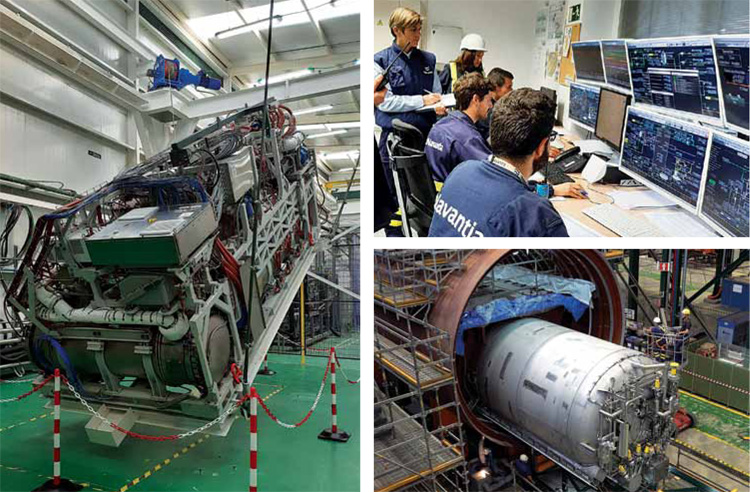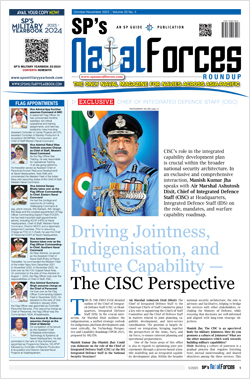INDIAN ARMED FORCES CHIEFS ON OUR RELENTLESS AND FOCUSED PUBLISHING EFFORTS

The insightful articles, inspiring narrations and analytical perspectives presented by the Editorial Team, establish an alluring connect with the reader. My compliments and best wishes to SP Guide Publications.

"Over the past 60 years, the growth of SP Guide Publications has mirrored the rising stature of Indian Navy. Its well-researched and informative magazines on Defence and Aerospace sector have served to shape an educated opinion of our military personnel, policy makers and the public alike. I wish SP's Publication team continued success, fair winds and following seas in all future endeavour!"

Since, its inception in 1964, SP Guide Publications has consistently demonstrated commitment to high-quality journalism in the aerospace and defence sectors, earning a well-deserved reputation as Asia's largest media house in this domain. I wish SP Guide Publications continued success in its pursuit of excellence.
- Global Partners Urged to Tap India's Shipbuilding Potential: Rajnath Singh at Samudra Utkarsh
- All about HAMMER Smart Precision Guided Weapon in India — “BEL-Safran Collaboration”
- India, Germany deepen defence ties as High Defence Committee charts ambitious plan
- G20 Summit: A Sign of Global Fracture
- True strategic autonomy will come only when our code is as indigenous as our hardware: Rajnath Singh
- India–Israel Joint Working Group Meeting on defence cooperation to boost technology sharing and co-development
TECHNOLOGY
Shipbuilder’s Perspective on P75(I) Project
The key for success for P75(I) is based mainly on two main pillars: superior engineering capabilities and flexibility towards complex contractual structure for industrial collaboration

Being in the shipbuilding business has never been a stable situation for the companies that have devoted their efforts into an activity that has high sensibility on events happening on the other corner of the world. In a business that focusses its activity on the maritime domain, where the seas bring globalisation connectivity along with strong competition, adaptiveness and flexibility are not “nice to have” capabilities but mandatory features to survive. If this is true for the civilian market, it is even more evident for the military business, where political decisions are also considered when investing on naval assets.
For the sake of staying a worldwide reference in the naval shipbuilding, Navantia has been constantly investing up to a non-neglectable 15 per cent in R&D, with a constant eye kept on the most important markets in the world. Navantia has proudly showcased a client-oriented attitude, harvesting consideration and trust from different national naval forces and governmental stakeholders, granting a privileged role on the most complex shipbuilding programmes around the globe.
As the latest example, Navantia is about to deliver to the Spanish Navy the first unit of AIP fitted S-80 class submarine, the S-81 “Isaac Peral”. This milestone will be a breakthrough in submarine design and building industry, not only because of the capabilities implemented on this ocean-going platform, but also for the differentiation due to Navantia’s proprietary BEST (Bio Ethanol Stealth Technology) AIP system. This R&D effort will payback by placing Navantia in a predominant position in the submarine market, responding to the market requirements of submarine user navies, with a safer, more reliable and proven stealth technology. Indeed, ThyssenKrupp Marine Systems proprietary AIP technology, used in current and future Korean and Turkish constructions among others, has been a reference in past years, driving a revolution in the conventional submarine market, and allowing Germany to maintain the historical prominent role in this industry. Navantia is looking to lead the next step on conventional submarine building business through this disruptive technology, being aware that, besides Germany, our competitors on the P75(I) project are either way behind in the development of a competitive AIP technology or depending on the German technology to provide an AIP fitted design to Indian Navy.
Navantia’s BEST AIP produces hydrogen from agricultural bioethanol, readily available worldwide, as opposed to other solutions in the market using high-purity diesel oil or methanol.
This challenge required the development of a cutting-edge Hydrogen generator -a high thermal efficiency miniaturised bioethanol processor- to feed a Proton Exchange Membrane (PEM) fuel cell developed ad hoc. Process fuel gases are perfectly diluted in seawater -avoiding presence of bubbles which could degrade submarine stealthiness- to guarantee an exceptional noise level performance as in pure electric diving.
The fuel cell is specifically developed to military naval specifications, not a commercial based PEM fuel cell adapted for submarine use. The cell stacks are made of porous bipolar plates for passive water management and uniform, continuous membrane humidification (no need for humidification or water removal systems). This advanced design does not only make the fuel cell simpler at the system level, but also provides double service life duration in comparison with the market standard operating on reformate gas and pure Oxygen (not air). This avoids the need for Hydrogen purification systems -such as a membrane- or simulate air, a further simplification of the system.
Navantia’s BEST AIP produces hydrogen from agricultural bioethanol, readily available worldwide, as opposed to other solutions in the market using high-purity diesel oil or methanol
Often a smoothly run project gets a black eye because of problems during implementation. As opposed to other third generation AIPs in the market, which remain at laboratory level without a project for implementation in the near term, Navantia’s BEST AIP is to be installed into a submarine under construction, the S-80 Plus. This is a step forward which emphasizes the uniqueness and maturity of Navantia’s AIP solution.
Long-term (land-based) tests have been completed at a test facility at the Cartagena shipyard (Spain), construction place of the S-80 plus, with a true submarine operational profile, confirming a submerged endurance of up to three weeks.
The whole system is ready to carry out the Factory Acceptance Tests of the first production unit in environmental conditions equivalent to “sea proven” and will be installed on board in 2023.
It is clear for us that the Indian Navy is right now going through a tough process launching the P75(I) submarine programme, with the difficulties of a cutting-edge technology submarine design and the arising contractual issues of local construction. From our perspective, the key for success for this project is based mainly on two main pillars: superior engineering capabilities and flexibility towards complex contractual structure for industrial collaboration.
Regarding the submarine design and engineering capabilities, Navantia is ready to take the lead on the next generation AIP systems and AIP fitted submarine design. The S-80 class being commissioned to Spanish Navy early 2023, Spain will join the reduced number of countries having full submarine design and construction capabilities. Also, familiar with any kind of systems in the market, no matter if they have to be installed in a surface or submarine platform, Navantia is able to include and to integrate different OEM’s equipment in the platform design, with demonstrated experience of more than 300 years in the business.
Besides the inhouse design and construction capabilities, as described earlier, Navantia also showcases great doses of adaptiveness and flexibility. As mentioned before, this is a must for all the entities taking part on the big naval programmes nowadays, but it is even more relevant for this long term, highly complex contract. There is no doubt that this project will be a reference in the medium and long term in the naval shipbuilding business, not only for the advanced technology involved but also the participation on the local industries. After the efforts Navantia has undertaken in building up the proper relationship with the Indian Industry that is meant to participate in the project through Atmanirbhar Bharat programme, it is clear that the proper flexible attitude and adaptative philosophy is present in the Indian Industry ecosystem, and that we will find good synergies with Indian OEM and suppliers. After the Industry Day event hosted by Navantia in April 2020, more than 400 equipment RFI’s were sent out, 90 main business areas for P75(I) project were identified and around 1500 market consultations were executed. After this, when covid outbreak allowed it, around 40 face-to-face meeting with Indian suppliers in different cities took place.
To sum up, there is a way through to get the P75(I) project goals successfully achieved with Navantia, where the association with the Strategic Partner is perceived as a long-term partnership, and the support of the Spanish Government to our company brings stability and support to provide a good service for the P75(I) project stakeholders. Reliability, commitment, and client satisfaction are Navantia’s leitmotif.





